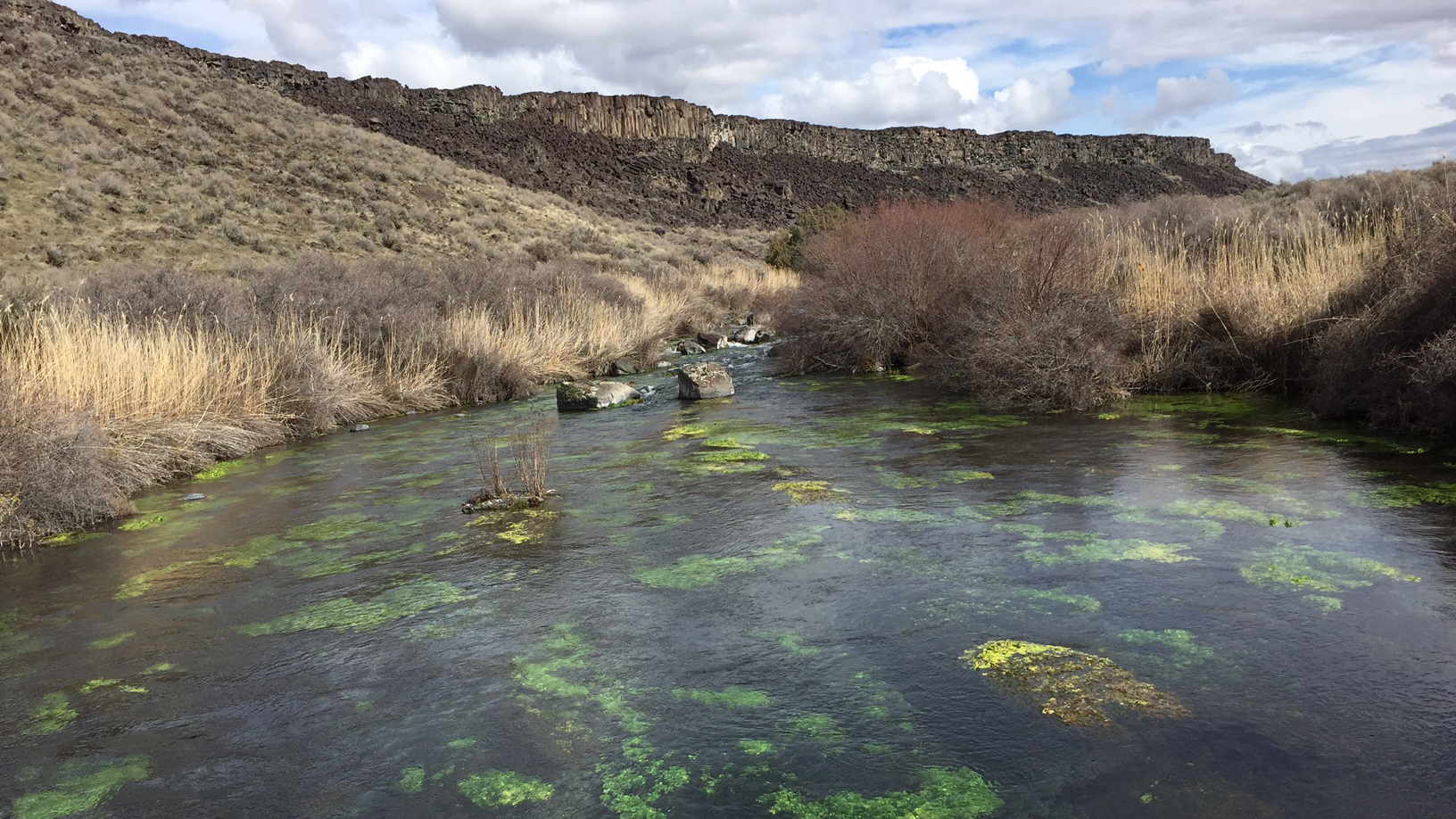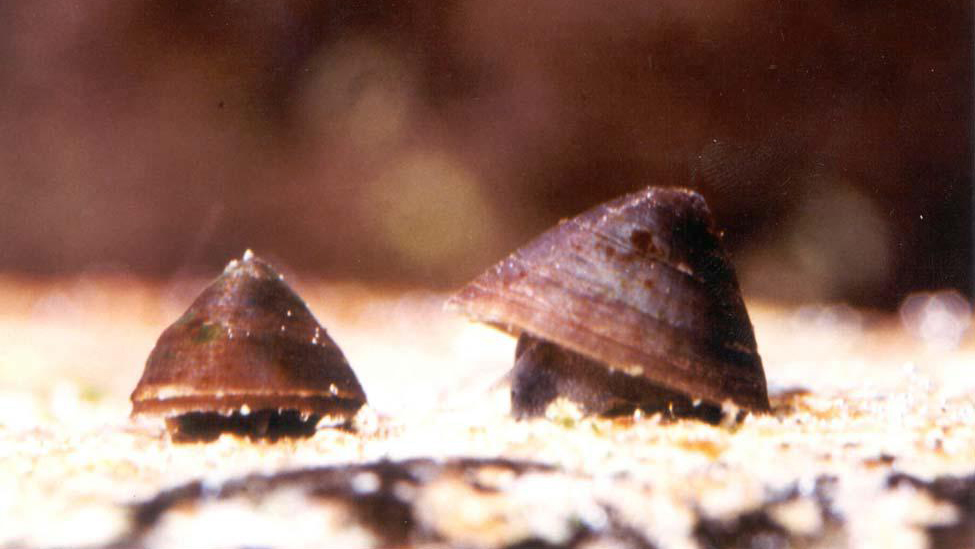I’m staring at a creature that, to put it mildly, would be easy to overlook. It’s a snail, but I wouldn’t have known that if I hadn’t been told. It just looks like a shell stuck to a rock, so tiny that I could easily drop it down the cap of my pen, and still have room for a couple dozen more.
It blends in with the rock, so it basically looks like a little dimple. Nobody will accuse the Banbury Springs lanx of being charismatic megafauna. At first glance there is nothing remarkable about it.
But when I look closer, and look around, everything about the Banbury Springs lanx is remarkable.
U.S. Fish and Wildlife Service biologists Greg Burak and Dave Hopper have invited me on their monitoring surveys for this snail species, found only in the Thousand Springs region of southern Idaho. The little snail we’re seeking may be unassuming, but its story can tell us a lot about geology, conservation and water in the West.
Secrets in Magic Valley
I join Burak and Hopper in their truck on an overcast spring morning. We motor south out of Boise on the interstate, getting off in an area along the Snake River known as the Magic Valley.
Seemingly endless fields of irrigated agriculture stretch out before me, tilled and muddy. Those farms are periodically interrupted by large, confined dairy operations: thousands of cows mill around in their pens. Anywhere you look, it’s an area dominated by intensive agriculture.
It was listed as an endangered species before it even was given a formal scientific name.
Greg Burak
It seems an unlikely place to be visiting crystal-clear springs, but that’s what we’re doing. In fact, the springs and the agriculture we’re passing are tied inextricably together.
The Snake River – the large tributary of the Columbia – winds its way through this part of Idaho. Along this section, crystal clear water bursts out of canyon walls, forming beautiful, Caribbean blue springs.
This water originates more than 100 miles to the north, where several rivers flow out of the Rocky Mountains into the extensive lava fields of Craters of the Moon National Monument. The rivers sink into the porous lava, and they flow underground until they hit the canyon. Other rives and creeks east of the monument also infiltrate into the groundwater, helping create one of the country’s largest aquifer systems. The watery journey can take 200 years before it emerges purified, clear and cold. But land uses over the aquifer appear to influence its volume and quality.

Historically, it must have been one of the wonders of the West, with thousands of springs cascading from the canyon. The area is still known as Thousand Springs. But all that clear water in the desert couldn’t go unnoticed.
As Idaho was settled, both the federal government and farmers worked to “make the desert bloom.” That involved dams and irrigation, of course, but it also involved tapping those springs. The Magic Valley became the largest center of trout aquaculture in the country, with acres of fish pools being fed the clear water.
But springs still remained scattered about the valley. These little jewels were popular among human visitors for their scenery: isolated desert canyons with blue waters, pretty waterfalls, bubbling springs. Some of the wildlife is quite apparent: golden and bald eagles soar overhead, thousands of waterfowl cluster on the surrounding Snake River. You might see a porcupine or even a bobcat scurrying into the rocks.
The smaller species – the ones you don’t readily see – are even more interesting.

Idaho’s Galapagos
Any student of biodiversity knows that isolated islands often contain endemic species, creatures found nowhere else. The Galapagos is the most famous example: home to a variety of finches that rapidly evolved into new species, as well as iguanas, lava lizards, and more.
Not all habitat islands are surrounded by water. In some cases, the islands are water. That’s the case in the Thousand Springs area. Even prior to agricultural development, these springs were isolated: little pockets of cold water in the desert. And in these pockets there are species found nowhere else on earth, including two snails (the Banbury Springs lanx and Bliss Rapids snail) and a fish (the Shoshone sculpin).
“The Banbury Springs lanx was first found in 1988,” says U.S. Fish and Wildlife Service biologist Greg Burak. “Though lacking a formal scientific name the first two decades after its discovery, it was recently identified as a new species. It was listed as an endangered species before it even was given a formal scientific name.”

More recently, it was given its formal scientific name and, as it turns out, is so unique that the experts who described it placed it within its own unique genus, Idaholanx, with a species name that honors its discoverer, Dr. Terry Frest.
“It’s found in four springs in the region,” says Burak. “Some populations are doing worse than others. Each population is isolated from the other. There’s essentially no chance of genetic exchange between populations.”
How did these little snails come to inhabit the springs in the first place? One hypothesis suggests they were denizens of Lake Idaho, a massive and ancient lake that drained an estimated two million years ago, cutting canyons and leaving the snails perhaps clinging to existence in the springs.

The springs themselves faced threats in the form of development. As Thousand Springs dwindled, conservationists feared the remaining habitat was doomed. One of the springs, Box Canyon, faced a particularly precarious future.
About 300 acres of land in the canyon was privately owned, and the owner had a water right to develop a fish farm by diverting a huge percentage of water out of Box Canyon. The Nature Conservancy purchased the property and associated water rights with the help of the State of Idaho. The Conservancy held the property for a few years while funding was lined up for the Idaho Department of Parks and Recreation to take full ownership and manage the site as a state park.
The Nature Conservancy also worked to acquire and protect other properties in the area. These have all been transferred to the State of Idaho and are now managed as part of the Thousand Springs State Park complex. They are open for the public to enjoy. And they’re home to tiny, rare species.
Lanx Patrol
Burak and fellow biologist Dave Hopper are monitoring snail populations in Box Canyon today. Like so many natural treasures of the Magic Valley, it’s hard to find Box Canyon until you’re almost in it. We bounce along a rutted dirt road, scaring the occasional marmot and then: a deep gorge, with gushing blue water flowing through the canyon floor.

Books have been written on water in the arid West, but it’s still largely unknown how the various uses of these springs affect the snails. “We still don’t know a lot about the snails,” says Hopper, who has been monitoring them for more than 10 years. “We are trying to determine what factors influence their populations. These springs could be affected by increased nutrients and sedimentation. New Zealand mud snails, an invasive species, are in the Snake River, but we don’t currently find them cohabiting.”
Water quantity plays a significant role in the snail’s survival, too. “Diversions of water influence their survival. They just can’t move rapidly,” says Burak. “When water levels drop, the snails may be left high and dry. If the depth of water drops, it also shrinks their available habitat.”
Studying the snail is difficult. With so few in the springs, you can’t collect them for laboratory research. “We’re not even sure if we could replicate their habitat conditions and keep them alive in a laboratory,” says Hopper.
We get out of truck and head into the springs. In Box Canyon, the snails are found along the springs in a piece of habitat shorter than a football field. You can make it across the water in two leaps.
Burak and Hopper set to work picking up rocks. The snails are limpets, cone-shaped snails that attach to rocks. Hermaphrodites, they lay eggs on submerged rocks and boulders; the young crawl away to graze on miscroscopic algae – that cling on rocks and boulders.

As the biologists look at rocks, they call out the snails they are finding, both juveniles and adults. They’ve done this before, but they are never certain what they will find. They’ve recorded anywhere from hundreds of snails to as few as 50 at this location, suggesting periodic population crashes.
Burak calls me over and shows me a rock with 12 Banbury Springs lanx. The rocks look to be speckled with tiny lumps.
Field wildlife research often conjures images of radio-tagging grizzly bears and jumping out of helicopters. Here, though, it’s sifting through rocks. The canyon itself is striking, but the biologists are hunched over the stream, counting snails.

Covering the entire length of the snail’s habitat, even with the biologists’ thorough searching, doesn’t take long. They finish and add up their tallies: 110 snails.
“That’s twice as many as last year,” says Burak.
As a conservation writer in Idaho for the past 16 years, I’ve written a lot about the state’s wildlife. With huge tracts of public lands, including wilderness, the state is still home to wide-ranging beasts like grizzlies and wolverines, as well as long migration routes for pronghorn and mule deer. Conservationists talk about landscape connectivity a lot – keeping big swaths protected so wildlife can move around. A pronghorn migration can cover 100 miles; a wolverine can cover even more.
But landscape connectivity isn’t just about big spaces. And biodiversity conservation isn’t just about big creatures. The little snails we’re counting are perfectly adapted to these springs, themselves created by their own unique combination of geology and water. I’m glad the U.S. Fish and Wildlife Service is tracking their populations and their needs.
“Landscape scale is a relative term,” says Burak. “Landscape scale for these guys is the length of this truck. But it is influenced by an entire watershed.”




What a fascinating discovery. Let’s hope that they multiply and remain a viable population. It is great to hear about new discoveries in our time, it is a pity that there is not more funding for biological research. Thank you for the article.
Excellent very well written article. Thank you.